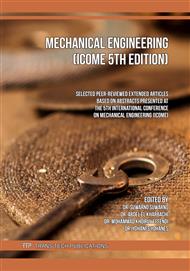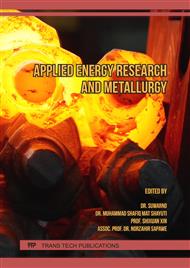[1]
M.P. Moran and D.K. Ott, Lead Free Frangible Ammunition Exposure at United States Air Force Small Arms Firing Ranges, in: Defense Technical Information Center Report IOH-RS-BR-TR-2008-0002, (2008).
DOI: 10.21236/ada486864
Google Scholar
[2]
S. W. Banovic, S. P. Mates, Microscopic fracture mechanisms observed on Cu–Sn frangible bullets under quasi-static and dynamic compression, Journal of Materials Science. 43 (2008) 4840–4848.
DOI: 10.1007/s10853-008-2702-2
Google Scholar
[3]
E. Salur, A. Aslan, M. Kuntoglu, A. Gunes, and O. S. Sahin, Experimental Study And Analysis Of Machinability Characteristics Of Metal Matrix Composites During Drilling, Composites Part B: Engineering Composites Part B. 166 (2019) 401–413.
DOI: 10.1016/j.compositesb.2019.02.023
Google Scholar
[4]
O. D. Neikov, Processing of Powders and Processing Equipment, in: Handbook of Non-Ferrous Metal Powders, Frantsevich Institute for Problems of Materials Science (IPMS), Ukraine, (2019).
DOI: 10.1016/b978-0-08-100543-9.00014-2
Google Scholar
[5]
R. M German, Particulate Composities Fundamental and Application, Springer International, Switzerland, (2016).
Google Scholar
[6]
M. Alian, , F. Ein-Mozaffari, S. R. Upreti, J. Wu, Using Discrete Element Method To Analyze The Mixing Of The Solid Particles In A Slant Cone Mixer, Chemical Engineering Research And Design. 93 (2015) 318–329.
DOI: 10.1016/j.cherd.2014.07.003
Google Scholar
[7]
S. Hitesh, M. Swati, J. Darshana, Process Optimization for Double-Cone Blender and Application of Statistics, International Journal of Pharmaceutical Research 3 (4) (2011) 18-23.
Google Scholar
[8]
W. Chen, J. Wang, S. Wang, P. Chen, J. Cheng, On the processing properties and friction behaviours during compaction of powder mixtures, Materials Science And Technology. (2020) 1–8.
DOI: 10.1080/02670836.2020.1747779
Google Scholar
[9]
A. Mohammadi, R. Mahmudi, Elevated-Temperature Mechanical Properties of Lead-Free Sn-0.7Cu-xSiC Nanocomposite Solders, Journal of Electronic Materials. 47 (2) (2018) 1721-1730.
DOI: 10.1007/s11664-017-5923-9
Google Scholar
[10]
A. Wagih, A. Fathy, Experimental Investigation And FE Simulation Of Spherical Indentation On Nano-Alumina Reinforced Copper-Matrix Composite Produced By Three Different Techniques, Advanced Powder Technology. 28 (8) (2017). 1954–(1965).
DOI: 10.1016/j.apt.2017.05.005
Google Scholar
[11]
T, S Kavithaa, L. Rangaraj, S, S.Avadhani, Significance of Interface Design Aspects and Characteristics in Cu/SiCp Composites Fabricated by the Powder Metallurgy Route, Mettalurgical and Material Tranactions A. (2019).
DOI: 10.1007/s11661-018-5089-y
Google Scholar
[12]
H. Jakub, Ž. David, J. LUCIE, Z. Jiří, N. Jan, Effect Of Particle Shape And Size On The Compressibility And Bulk Properties Of Powders In Powder Metallurgy, Proceedings 25th Anniversary International Conference on Metallurgy and Materials. (2016) 1394-1399.
Google Scholar
[13]
G. Y. Jang, J. W. Lee, J. G. Duh, The Nanoindentation Characteristics of Cu6Sn5, Cu3Sn, and Ni3Sn4 Intermetallic Compounds In The Solder Bump, Journal Electronic Materials. 33 (2004) 1103–1110.
DOI: 10.1007/s11664-004-0111-0
Google Scholar
[14]
G. Grathwohl & R. Warren, The effect of cobalt content on the microstructure of liquid-phase sintered TaC-Co alloys, Materials Science and Engineering. 14 (1) (1974) 55–65.
DOI: 10.1016/0025-5416(74)90123-2
Google Scholar
[15]
G. K. Gyimah, P. Huang, D. Chen, Dry Sliding Wear Studies of Copper-Based Powder Metallurgy Brake Materials, Journal of Tribology. 136 (2014).
DOI: 10.1115/1.4027477
Google Scholar
[16]
J. Li, H. Zhang, Y. Zhang, Z. Che, X. Wang.: Microstructure and Thermal Conductivity of Cu/diamond Composites with Ti-coated Diamond Particles Produced By Gas Pressure Infiltration, Journal Alloy Compound. 647 (2015) 941–946.
DOI: 10.1016/j.jallcom.2015.06.062
Google Scholar
[17]
Kruachatturat, Sintering Cu-Sn Materials for Frangible Bullets, The 3rd Thailand Metallurgical Conference, Bangkok, Thailand, (2009).
Google Scholar
[18]
X. S. Bui, J. Komenda, and R. Vitek, Frangibility Quantification of Frangible Bullet upon Impact on a Hard Target, Defence Science Journal. 71 (2) (2021) 171-176.
DOI: 10.1109/miltechs.2017.7988721
Google Scholar



